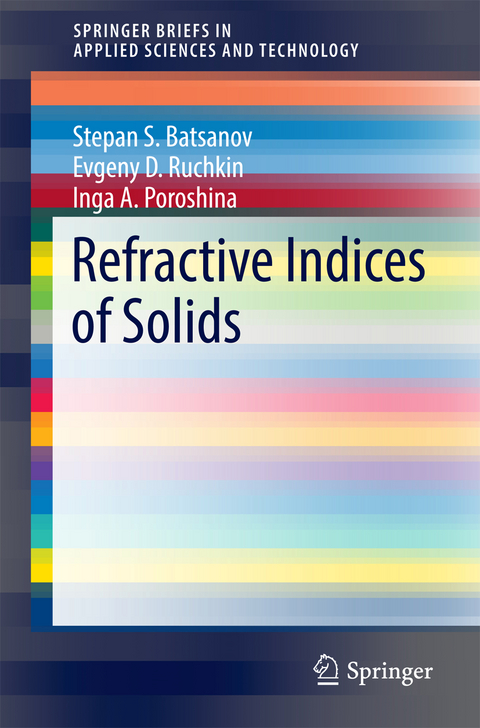
Refractive Indices of Solids
Springer Verlag, Singapore
978-981-10-0796-5 (ISBN)
Stepan Sergeevich Batsanov was born in Moscow (9.11.1928), obtained his MSc in chemistry (1951) and PhD on crystal-optical determination of the structure of complexes (1954) from Moscow University, and DSc on refractometric methods in structural chemistry (1962) and chair in physical chemistry (1965) at Novosibirsk University. His main scientific interests are in crystal optics, chemical structure and bonding, and (from 1966) shock-pressure chemistry and physics. He was the founder and director (in 1970-2010) of the Centre for High Dynamic Pressures (CHDP) of the State Committee of Standards at Mendeleevo, near Moscow. He authored and co-authored over 500 scientific papers and 8 books, including the Structural Refractometry (in Russian, 1959, 2nd ed. 1976, English editions by Consultants Bureau, New York, 1961 & Van Nostrand, 1966), Effects of Explosions on Materials (Springer Verlag, 1994) and Introduction to Structural Chemistry (Springer, 2012). Evgenii Dmitrievich Ruchkin was born in Moscow (23.07.1937), graduated from Moscow University (chemistry) in 1952. He worked at the Institute of Inorganic Chemistry in Novosibirsk (1959-1968), where in 1964 he received his PhD (supervised by S.S. Batsanov) on crystal-optical analysis of inorganic compounds, CHDP (1968-1973) and the Institute of Materials Science in Moscow (1973-1979). From 1979 he was a lecturer at Moscow Medical Institute, until retiring in 2011. He authored over 70 scientific papers, including 40 on crystal optics. Inga Anatolyevna Poroshina was born (16.03.1939) in Novokuznetsk in Siberia, graduated from the University of Tomsk (geology & geochemistry) in 1962 and obtained her PhD (supervised by S.S. Batsanov) from Moscow University in 1979, her thesis was entitled “Determination of elements of silicate structures by crystal optics and refractometry”. From 1963 to 1980 she worked at the Institute of Solid State Chemistry (Novosibirsk). From 1981 till now she is a lecturer at theNovosibirsk Pedagogical Institute. She authored 90 scientific papers, 61 of them in crystal optics.
Anisotropy, dispersion, theory, effect of structure.- Anisotropy, dispersion, theory, effect of structure.- Chemical bonding and refractive indices.- Refractive indices of elements and binary compounds.- Refractive indices of ternary or complex halides and oxides.- Refractive indices of silicates and germinates.- Refractive indices of uranium compounds.- Refractive indices of the oxygen-containing salts.- Refractive indices in the coordination compounds of b-elements.- Refractive indices in coordination compounds of a-metals.- Crystallohydrates of simple and complex compounds.- Refractive indices of selected organic compounds.
| Erscheinungsdatum | 08.10.2016 |
|---|---|
| Reihe/Serie | SpringerBriefs in Applied Sciences and Technology |
| Zusatzinfo | IX, 108 p. |
| Verlagsort | Singapore |
| Sprache | englisch |
| Maße | 155 x 235 mm |
| Themenwelt | Naturwissenschaften ► Chemie ► Analytische Chemie |
| Naturwissenschaften ► Geowissenschaften ► Geologie | |
| Naturwissenschaften ► Geowissenschaften ► Mineralogie / Paläontologie | |
| Technik ► Maschinenbau | |
| Schlagworte | Anhydrous Solids • Anisotropy of Solids • crystal optics • Highly-refracting Powders • Mineral Chemical Structures • Optical/Structural Refractometry • RI of Uranium Compounds • Silicate Structures • Ternary Halides |
| ISBN-10 | 981-10-0796-9 / 9811007969 |
| ISBN-13 | 978-981-10-0796-5 / 9789811007965 |
| Zustand | Neuware |
| Haben Sie eine Frage zum Produkt? |
aus dem Bereich


